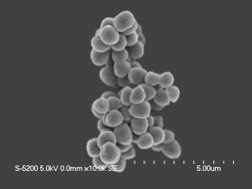Kocuria rhizophila DC2201(= NBRC 103217)
The soil actinomycete Kocuria rhizophila is a coccoid, gram-positive bacterium. It belongs to the family Micrococcaceae in the suborder Micrococcineae, a divergent bacterial group for which only limited amount of genomic information is currently available. The type strain of K. rhizophila (DSM 11926T) was isolated from the rhizosphere of narrowleaf cattail (Typha angustifolia).[1] The genus Kocuria was created from the genus Micrococcus on the basis of the phylogenetic and chemotaxonomic dissection of the genus Micrococcus.[2] Members of the genus Kocuria were isolated from a wide variety of natural sources including mammalian skin, soil, the rhizosphere, fermented foods, clinical specimens, fresh water and marine sediments. K. rhizophila ATCC 9341, formerly Micrococcus luteus, is designated as a quality-control strain in a number of applications, including susceptibility assays for a variety of antibiotics.[3] K. rhizophila DC2201 (= NBRC 103217) was derived from IFO 12708 and characterized as a strain exhibiting tolerance to a wide variety of organic solvents.[4] The small genome size, the ability to grow rapidly and at high cell density, and the robustness of the cells at various growth conditions[4] would be highly advantageous for the development of bacterial bioconversion system which could be used under harsh conditions such as in organic solvents.
Sequencing and annotation of the genome of K. rhizophila DC2201 (= NBRC 103217) revealed a single circular chromosome (2,697,540 bp; G+C content of 71.16%) containing 2,356 predicted protein-coding genes. Most of the predicted proteins (87.7%) were orthologous to actinobacterial proteins, and the genome showed fairly good synteny with taxonomically related actinobacterial genomes. On the other hand, the genome seems to encode much smaller numbers of proteins necessary for secondary metabolism (one each of nonribosomal peptide synthetase and type III polyketide synthase), transcriptional regulation and lateral gene transfer, reflecting the small genome size. The presence of probable metabolic pathways for the transformation of phenolic compounds generated from the decomposition of plant materials, and the presence of a large number of genes associated with membrane transport, particularly amino acid transporters and drug efflux pumps, may contribute to the organism's utilization of root exudates as well as the tolerance to various organic compounds.
This work was conducted as a part of the project "Development of a Technological Infrastructure for Industrial Bioprocesses" of the New Energy and Industrial Technology Development Organization (NEDO), Japan.

Photo by
Dr. Tamura (NBRC, NITE)
References:
[1] Kocuria palustris sp. nov. and Kocuria rhizophila sp. nov., isolated from the rhizoplane of the narrow-leaved cattail (Typha angustifolia).- Kovacs, G., J. Burghardt, S. Pradella, P. Schumann, E. Stackebrandt, and K. Marialigeti.(1999)
Int J Syst Bacteriol 49 Pt 1:167-73. [PMID:10028258] - [2] Taxonomic dissection of the genus Micrococcus : Kocuria gen. nov., Nesterenkonia gen. nov., Kytococcus gen. nov., Dermacoccus gen. nov., and Micrococcus Cohn 1872 gen. emend.
- Stackebrandt, E., C. Koch, O. Gvozdiak, and P. Schumann. (1995)
Int. J. Syst. Bacteriol. 45:682-692. [PMID:7547287] - [3] Reclassification of ATCC 9341 from Micrococcus luteus to Kocuria rhizophila.
- Tang, J. S., and P. M. Gillevet. (2003)
Int J Syst Evol Microbiol 53:995-7. [PMID:12892116] - [4] The cell structural properties of Kocuria rhizophila for aliphatic alcohol exposure.
- Fujita, K., Hagishita, T., Kurita, S., Kawakura, Y., Kobayashi, Y., Matsuyama, A. and Iwahashi, H. (2006)
Enzyme Microb. Technol. 39:511-518.
| Genomic size: | 2,697,540 bp |
|---|---|
| The number of ORFs: | 2,356 |
| GC content: | 71.2% |
| Genome Database: | DOGAN |
| NBRC* No. : | 103217 |
- *:
- NBRC is the acronym for "the NITE Biological Resource Center".
The URL of NBRC is http://www.nbrc.nite.go.jp/e/index.html.
- Distribution of Our Microbial Genomic DNAs
- At the Biological Resource Center of the National Institute of Technology and Evaluation (NITE Biological Resource Center, an Incorporated Administrative Agency), we have been distributing the microbial genomic DNA.
Contact us
- Biotechnology Evaluation and Development Division, Biological Resource Center, National Institute of Technology and Evaluation
-
Address:2-49-10 Nishihara, Shibuya-ku, Tokyo 1510066, Japan MAP
Contact Form


